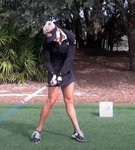GolfLivesMatter
Well-known member
- Thread starter
- #26
I get what you're saying but I also watched the long drive contest with junior girls and the winner hit a 250 yard drive. Amazing efficiency in their swing sequencing and club head speed for their age / size.I can see where a faster back swing, delivering a faster club head into the ball has some merit. I just don't think it's the right way to go for all golfers.
When it come to swing speed I always go back to the old swing guru's opinion that an individual, amateur golfer can only swing so fast, and still maintain control of the club head at ball impact. In other words not everyone can swing a driver 100+ mph.
I think amateur golfers can learn to swing faster, but only to point that their body will allow. Everyone is different.











